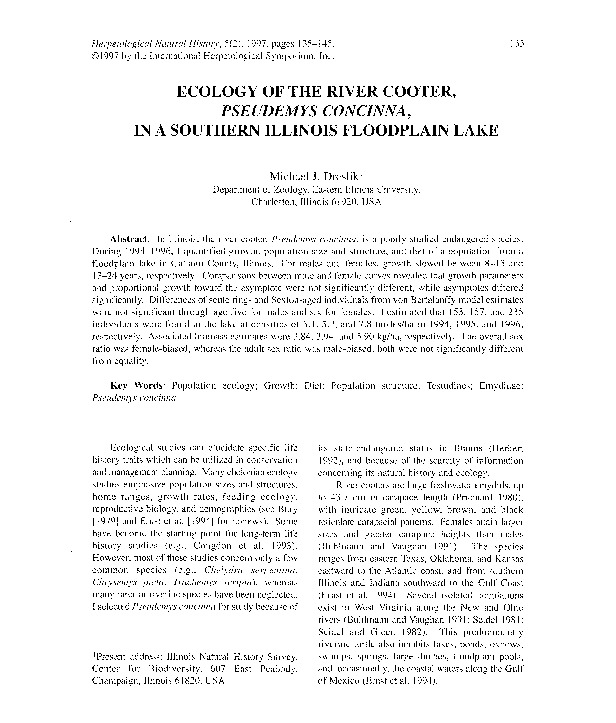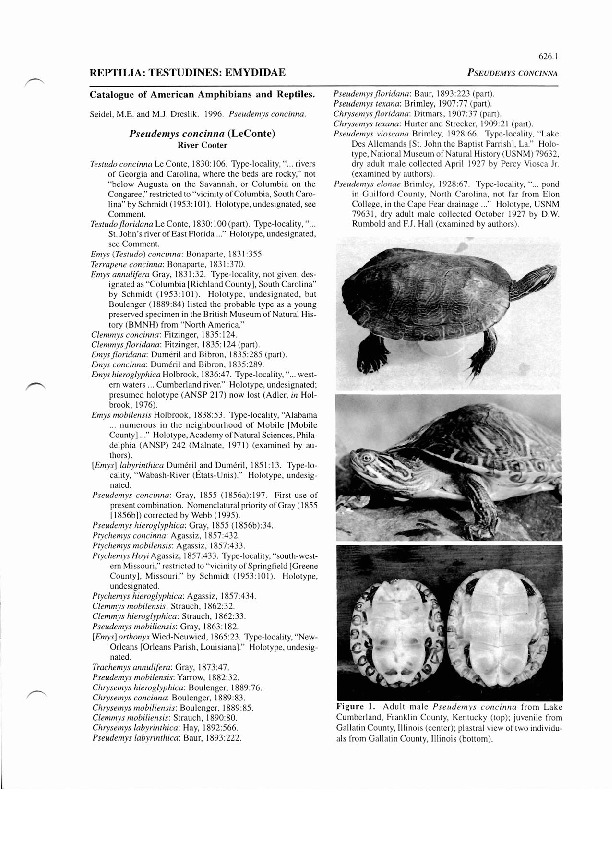- Jellen, B. C., C. A. Phillips, M. J. Dreslik, and D. B. Shepard.2007. SISTRURUS CATENATUS (Eastern Massasauga). REPRODUCTION. Herpetological Review. 38:343–344.
- Baker, S. J., D. Kirk, C. E. Schmidt, and M. J. Dreslik. 2007.REGINA GRAHAMII. (Graham’s Crayfish Snake). Herpetological Review. 38:105–106.
- Dreslik, M. J., and C. A. Phillips. Clemmy guttata (Schneider). 2006. Pp 69. In Nyböer, R. W., J. R. Herkert, and J. E. Ebinger (eds.). Endangered and threatened species of Illinois: Status and distribution, Volume 2 – Animals. Illinois Endangered Species Protection Board. Springfield, Illinois. 181 pp.
- Dreslik, M. J., and C. A. Phillips. Emydoidea blandingii (Holbrook). 2006. Pp 73. In Nyböer, R. W., J. R. Herkert, and J. E. Ebinger (eds.). Endangered and threatened species of Illinois: Status and distribution, Volume 2 – Animals. Illinois Endangered Species Protection Board. Springfield, Illinois. 181 pp.
- Dreslik, M. J., and C. A. Phillips. 2006. Kinosternon flavescens (Agassiz). Pp 77. In Nyböer, R. W., J. R. Herkert, and J. E. Ebinger (eds.). Endangered and threatened species of Illinois: Status and distribution, Volume 2 – Animals. Illinois Endangered Species Protection Board. Springfield, Illinois. 181 pp.
- Dreslik, M. J., and C. A. Phillips. 2006. Macrochelys temminckii (Harlan). Pp 78. In Nyböer, R. W., J. R. Herkert, and J. E. Ebinger (eds.). Endangered and threatened species of Illinois: Status and distribution, Volume 2 – Animals. Illinois Endangered Species Protection Board. Springfield, Illinois. 181 pp.
- Dreslik, M. J., and C. A. Phillips. 2006. Pseudemys concinna (Le Conte). Pp 82. In Nyböer, R. W., J. R. Herkert, and J. E. Ebinger (eds.). Endangered and threatened species of Illinois: Status and distribution, Volume 2 – Animals. Illinois Endangered Species Protection Board. Springfield, Illinois. 181 pp.
- Dreslik, M. J., and J. M. Mui. 2005. Pseudacris crucifer crucifer (Northern Spring Peeper): Aggressive behavior. Herpetological Review. 36:45.
- Anton, T. G., D. Mauger, C. A. Phillips, M. J. Dreslik, J. E. Petzing, A. R. Kuhns, and J. M. Mui. 2003. Clonophis kirtlandii (Kirtland’s snake): Aggregating behavior and site fidelity. Herpetological Review. 34:248–249.
- Shepard, D. B., M. J. Dreslik, C. A. Phillips, and B. C. Jellen. 2003. Sistrurus catenatus catenatus (Eastern Massasauga): Male–Male Aggression. Herpetological Review. 34:155–156.
- Dreslik, M. J. 1997. An inexpensive method for creating spaghetti tags for marking trionychid turtles. Herpetological Review. 28:33.
- Dreslik, M. J. 1997. A note on the foraging behavior of Pseudemys concinna. Bulletin of the Chicago Herpetological Society. 32:105.
Category: Research
The First Record of an Alligator Snapping Turtle (Macrochelys temminckii) in Illinois in 30 Years
Ethan J. Kessler1,*, Christopher A. Phillips1, Scott R. Ballard2, and Michael J. Dreslik1
Abstract – Macrochelys temminckii (Alligator Snapping Turtle) populations have experienced range-wide declines over the past century, and records of this species have become increasingly rare in the northern portion of its range. We report the first record of an Alligator Snapping Turtle in Illinois since 1984, only the second in the past 50 years. This individual was captured in a tributary of the undammed portion of the Mississippi River in close proximity to the last 3 published records in Illinois. It is possible that this region provides the last accessible, suitable habitat for this species in Illinois.
1Illinois Natural History Survey, University of Illinois at Urbana-Champaign, 1816 S. Oak Street, Champaign, IL 61820.
2Illinois Department of Natural Resources, 9053 Route 148, Suite B, Marion, IL 62959.
*Corresponding author – ekessle2@illinois.edu.
Dietary notes on the Red-Eared Slider (Trachemys scripta) and River Cooter (Pseudemys concinna) from southern Illinois.
Michael J. Dreslik
Abstract. The primary focus of this study was to ascertain the presence of sexual, seasonal, or ontogenetic differences in the diets of Trachemys scripta and Pseudemys concinna captured at Round Pond, Gallatin County, Illinois, between 17 May 1994 and 30 August 1995. I collected feces from T. scripta and P. concinna and separated the contents into eleven dietary categories for T. scripta and two for P. concinna. I quantified fecal volume by water cc displacement, then described each dietary category by frequency of occurrence, percent volume, and relative percent volume. Juvenile T. scripta fecal contents comprised >70% plant matter, while adult males and females had equal proportions of plant and animal matter in their feces. Percent volume and relative percent volume for T. scripta fecal samples did not differ between males and females, or between females and juveniles; however, I detected significant differences between males and juveniles and early (May-June) and late (July-August) samples. Overall the diversity of food items in the diet of T. scripta was large (Shannon index = 2.50) and the diversity of items expanded from early (Shannon index = 1.19) to late season (Shannon index = 2.72). Females consumed more mollusks than males, and males and females consumed more bryozoans than juveniles. I found Mollusks and bryozoans only in late season samples. Pseudemys concinna was herbivorous, specializing on epiphytic filamentous algae of the genera Cladophora and Oedogonium, with no differences in the frequencies of occurrence between males, females, and juveniles.
Illinois Natural History Survey, Center for Biodiversity, 607 East Peabody Drive, Champaign, IL 61820
Ecology of the River Cooter (Pseudemys concinna) in a southern Illinois flood–plain lake
Michael J. Dreslik1
Abstract. In Illinois, the river cooter, Pseudemys concinna. is a poorly studied endangered species. During 1994-1996. I quantified growth, population size and structure. and diet of a population from a floodplain lake in Gallatin County, Illinois. For males and females. growth slowed between 8-15 and 13-24 years, respectively. Comparisons between male and female curves revealed that growth parameters and proportional growth toward the asymptote were not significantly different, while asymptotes differed significantly. Differences of scute ring- and Sexton-aged individuals from von Bertalanffy model estimates were not significant through age five for males and six for females. I estimated that 153, !57, and 235 individuals were found in the lake at densities of 5.1, 5.2, and 7.8 turtles/ha in 1994. 1995, and 1996, respectively. Associated biomass estimates were 3.84, 3.94, and 5.90 kg/ha, respectively. The overall sex ratio was female-biased, whereas the adult sex ratio was male-biased; both were not significantly different from equality.
1Department of Zoology, Eastern Illinois University, Charleston, Illinois 61920, USA
River Cooter (Pseudemys concinna)
Michael E. Seidel1,* and Michael J. Dreslik2
The Society for the Study of Amphibians and Reptiles regularly publishes and updates species accounts in the Catalogue of American Amphibians and Reptiles. These accounts are to be exhaustive searches and references for the particular species in question. The series began in 1963, and now they are all open access and available online for free download at a University of Texas repository. Our account covered all of the literature to date for the River Cooter (Pseudemys concinna).
1Department of Biological Sciences, Marshall University, Huntington, WV 25755-2510
2Department of Zoology, Eastern Illinois University, Charleston, IL 61920-3099




